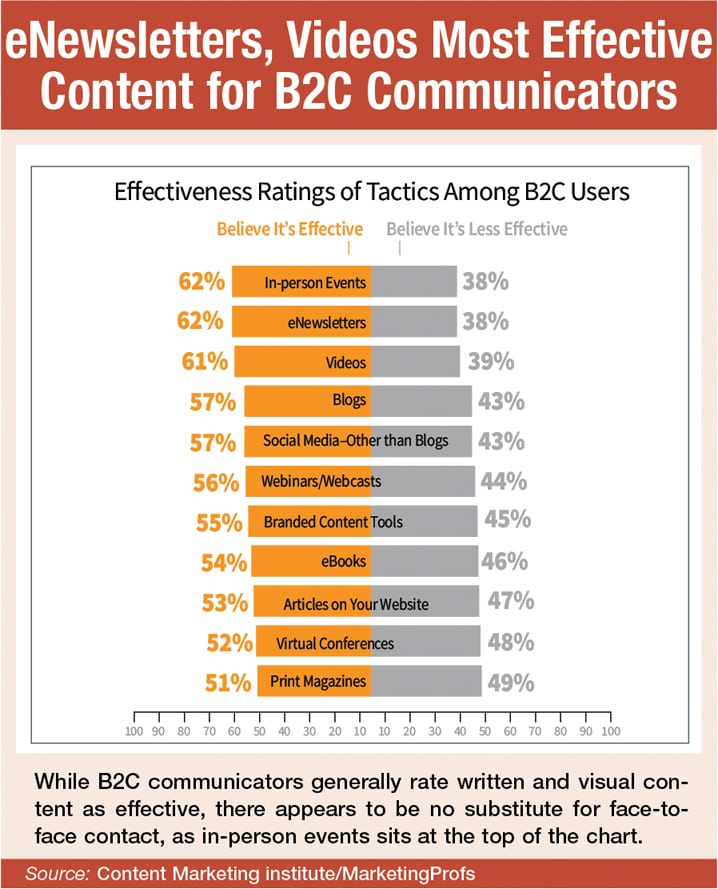As the term “content marketing” becomes de rigueur in both marketing and public relations precincts, communicators are scrambling to find the resources and develop the processes to turn their organizations into content factories.
But we’ve got news for you—if you’re worth your PR salt, you’ve been a content marketer for eons, just not in the organized way that smart communicators are currently practicing it.
“Content marketing is just an umbrella term that suggests a more efficient and more integrated process,” says David Patton, VP, editor-in-chief, at Waggener Edstrom Worldwide. “Today you need to be thinking about how audiences will discover your brand’s content across a variety of platforms.”
And plenty of PR pros and marketers are thinking about—and acting on—content marketing.
 |
In its 2013 Benchmarks and Trends Research study, the Content Marketing Institute found that 86% of B2C marketers use content marketing, employing on average 12 individual tactics. On average, 28% of B2C marketing budgets are allocated to content marketing, and 55% of marketers plan to increase their content marketing spend. B2B findings this year are similar.
Why this explosion of content efforts? There are a number of factors, including:
• You might have heard the phrase, “Think like a publisher.” Well, you can actually be publisher today and it will cost you pennies, if that.
• Social media has dramatically changed the way content is disseminated. But there are two sides to the social coin: While it’s easier to push your content out to followers with social platforms, the use of those platforms requires that content be compelling to have any chance of reaching a wide audience.
• Revised search technology (i.e. Google’s Panda and Penguin updates) requires content from credible sources. Without it, a brand won’t remain at or near the top search results for long.
In addition, there’s plenty of talent for organizations to tap in order to ramp up content efforts. Patton is a prime example. He was a senior editor with The Wall Street Journal before moving into the content- marketing space.
Having the resources to churn out content is one of the challenges, Patton says. Another is strategizing on the content. Eliza Ånderson, global PR manager at Intrepid Travel, based in Melbourne, Australia, says the company gets all of its channel managers (Facebook, Twitter, Pinterest, newsletter and campaign copywriters) in a room to discuss the business need and how to develop a meaningful conversation with audiences.
Getting the big content picture is important before churning out blogs, white papers, videos and more for specific campaigns, but that’s a challenge for Anderson and her team. “We want every campaign to feed into an overall and continuous discussion we have with our audiences about our brand, products and people.”
COLLECTION & CONTROL
Overall content strategy is a requirement, but the next step is equally crucial: collecting great stories and content across the organization. Chad Melton,
manager of digital marketing and user experience at Ingersoll Rand, does just that. He’s currently digitizing about 100 years’ worth of content from Ingersoll’s Compressed Air Magazine.
Finding content is a big task at Ingersoll Rand, a global company with about 50,000 employees. “We have great expertise within our company, but the trick is harnessing it and sending it out on the right channels,” Melton says. “If someone in the company writes a story for a trade publication, we need to maximize the reach by republishing it on our website and tweeting about it.”
CHANNEL SURFING
The task is to figure out which platforms will give the most bang for the content. Melton says video is working well for the brand. Outside of China, YouTube is one of the company’s main content platforms. Melton and his team maintain four Ingersoll Rand YouTube channels, with views totaling in the hundreds of thousands.
Anderson amplified the effectiveness of video. In an outside-the-box tactic, Intrepid Travel partnered with the YouTube food channel Tastemade to distribute Intrepid Travel’s videos. “It’s important to know the worth of your content to different audiences,” Anderson says.
Whatever the content, it’s all about being efficient and targeted in your content-marketing efforts. Here are some tips from Patton on how to optimize that efficiency:
1. Collaborate internally. “PR, marketing and advertising are often separate entities. They need to be integrated,” Patton says.
2. Develop a flow of content. The day-to-day content could be earnings and other news of interest to your audience. “Stock content” is more feature-like pieces (read: The New York Times ’ “Avalanche at Tunnel Creek” opus). Map this content out for regular release.
3. Create content templates. “ The Times does its ‘20 Questions’ feature in the Sunday magazine each week,” Patton says. “It’s standard, consistent and very easy for them to create.” So think about a “5 Questions With….” for your content pipeline.
The trick is to find the value in all of this content creation, or else you, your team and your boss will be mightily frustrated. “It’s getting that next click,” Patton says. So, calls to action connected to your content are critical. “Download the white paper” and “talk to an agent” all lead to better outcomes.
Getting to that next level has stymied many communicators so far, Patton says. But as content knowledge and sophistication grows, so will positive outcomes. PRN
( Catch Anderson, Melton and Patten imparting their content marketing expertise at PR News’ Digital PR Summit on Feb. 27 in San Francisco; prnewsonline.com/digitalsummitsanfran13/.)
CONTACT:
Eliza Anderson, @eliza_tron; Chad Melton, @Ingersoll_Rand; David Patton, @davidapatton.
